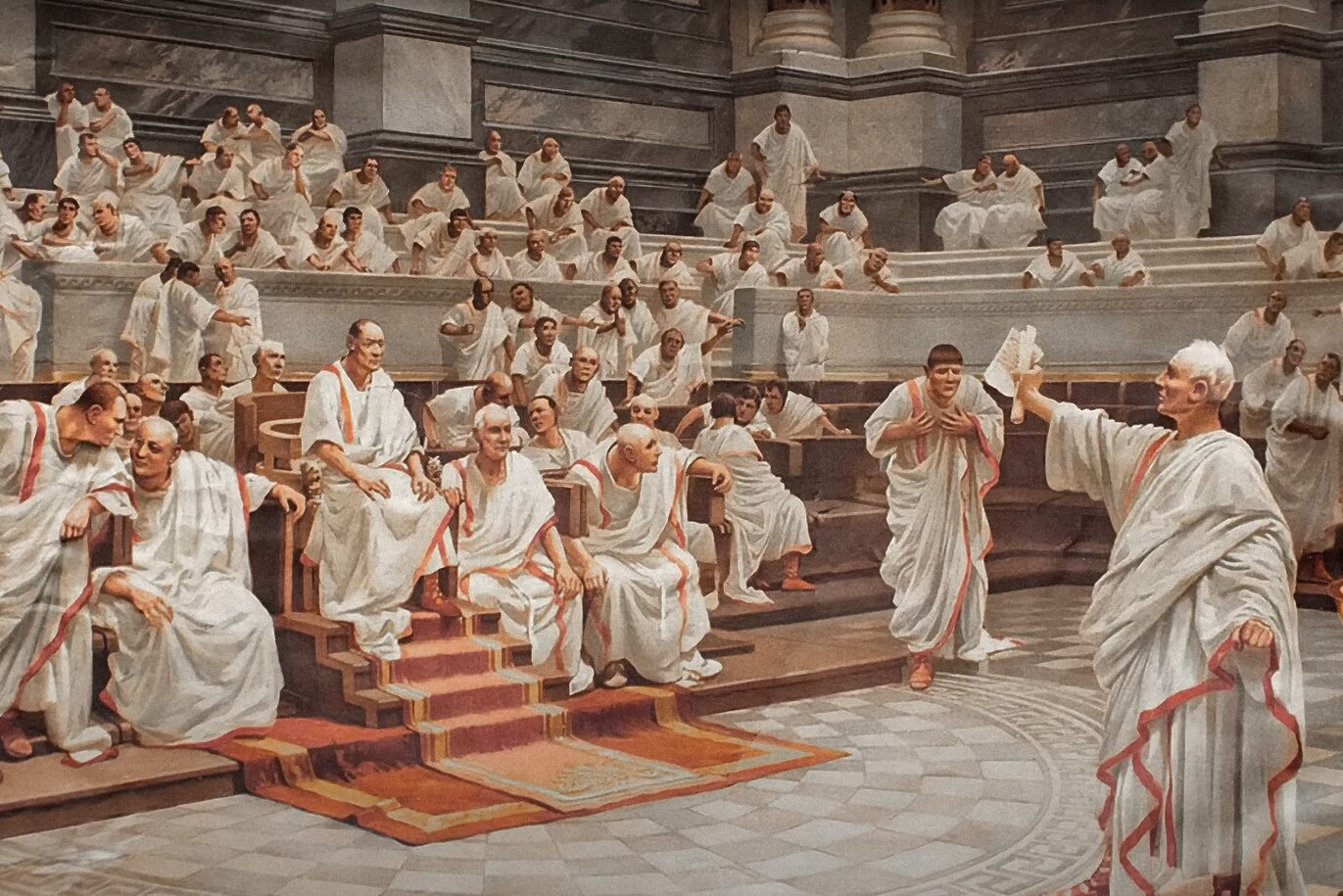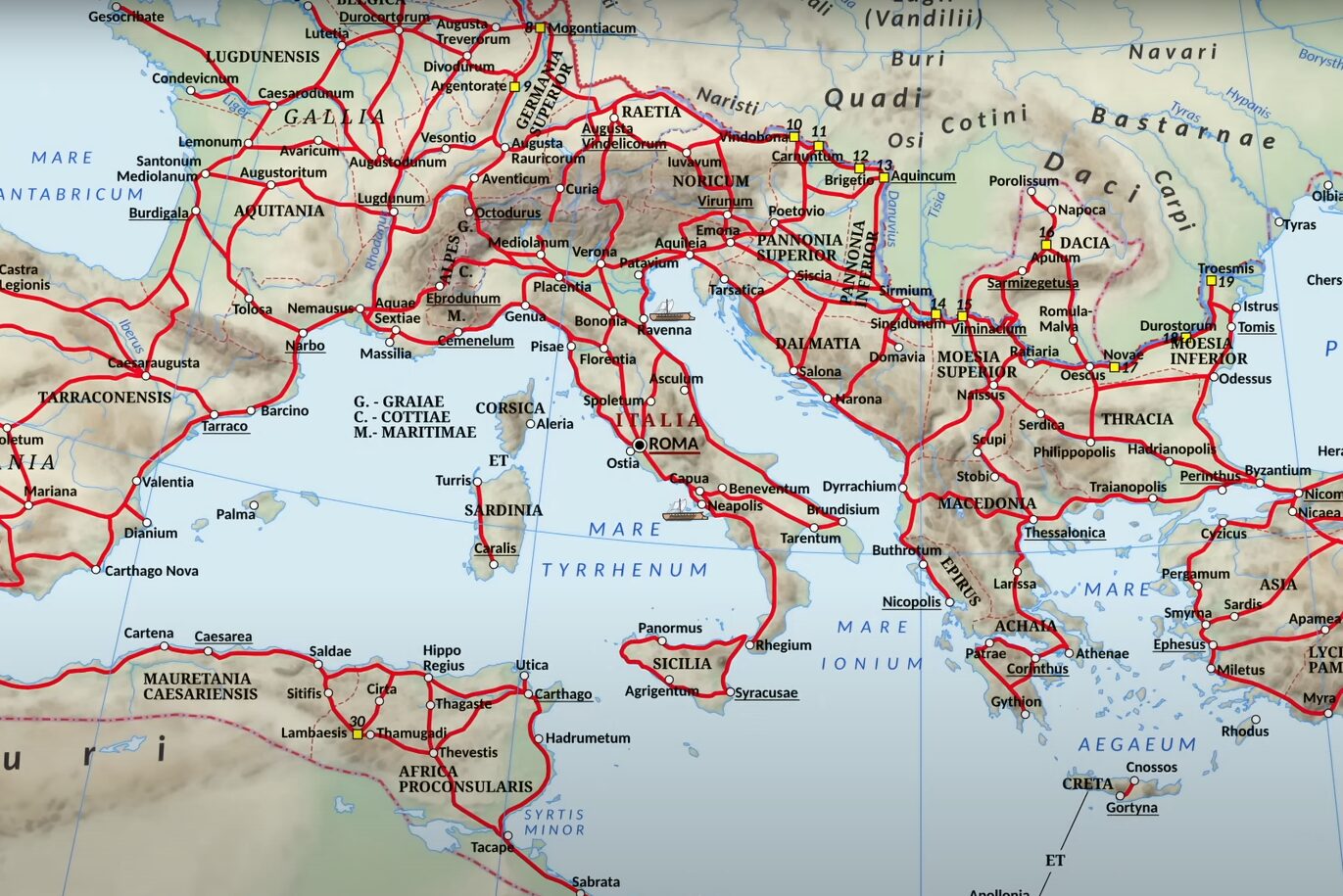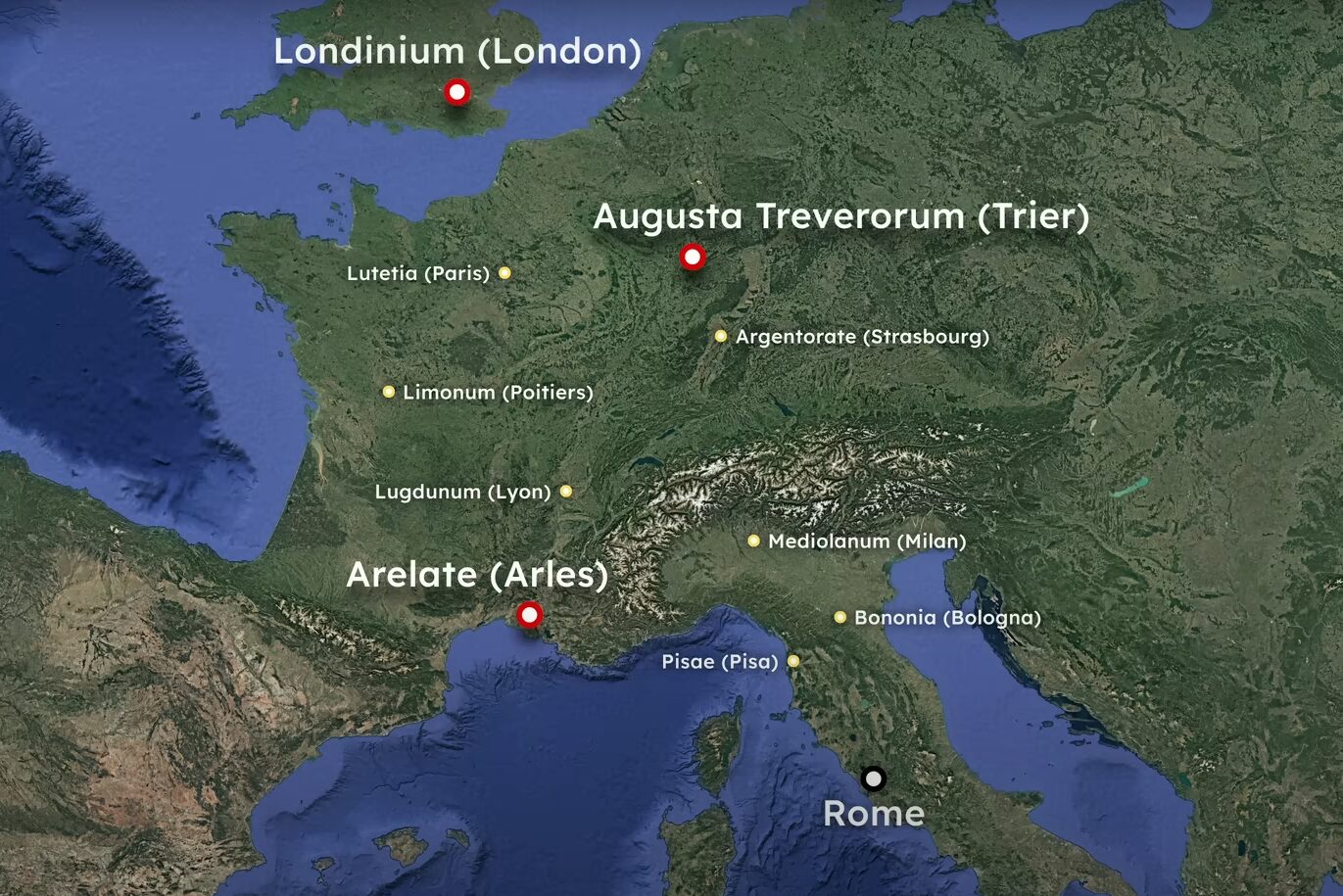Many modern cities like London, Paris, and Milan can trace their roots back to the Roman Empire, which built a vast urban network stretching from Britain to Syria. While some Roman-founded cities are still full of life, many others have disappeared, leaving behind only ruins.
The story of Roman cities is a story of growth and decline. Their fate depended on politics, trade, environment, and outside invasions. Understanding why these cities flourished and later faded offers a look at the strengths and weaknesses of complex societies.
Key Takeaways
- Roman cities formed a wide network, shaping much of Europe and beyond.
- Changes in government, economy, and the environment led to their decline.
- External threats and shifting trade routes played key roles in their fate.
How Roman Cities Connected the Empire
How Roman Cities Began
Roman cities started as Rome itself grew from a single city-state. As the Romans expanded their control, they founded new communities wherever none existed before. These towns were set up in a network that reached all the way from Britain to Syria, creating thousands of linked cities across the empire.
This spread of cities helped connect different regions and people. Many modern cities in Europe, such as London and Paris, began as Roman settlements. While some still exist today, hundreds of others have vanished, leaving only ruins behind.
What Roman Cities Did and Who Ran Them
Every Roman city had its own set area to manage and was led by local elites. These leaders collected taxes, enforced laws, and kept the region in order. In exchange, they received chances to grow wealthy and rise in power under Roman rule.
A city’s leaders were expected to take care of public affairs. They balanced the needs of the region, managed public spending, and acted as go-betweens for Rome and the countryside. At times, these duties became too hard, especially when the empire’s economy struggled or invasions threatened stability. In some places, the wealthiest citizens left for jobs in the imperial government, causing the city governments to weaken.
Responsibilities of Roman City Leaders
- Collect taxes for Rome
- Maintain peace and order
- Oversee local construction projects
- Support public events and infrastructure
Buildings and Public Projects in Roman Cities

Roman cities were known for their impressive public buildings. Local elites spent large amounts of money to show their status by funding structures such as:
- Forums (main public squares)
- Fountains
- Aqueducts (water channels)
- Baths and gymnasiums
- Amphitheaters
A Sample List of Typical Roman Public Works:
| Structure Type | Main Purpose |
|---|---|
| Forum | Meetings and ceremonies |
| Aqueduct | Water supply |
| Baths | Hygiene and gathering place |
| Amphitheater | Public shows and games |
| Roads | Travel and trade |
Monuments lined the streets, and statues honored generous citizens. Many of these buildings still shape how we picture Roman life. Even after cities declined from invasions or economic issues, parts of these public works often survived, hinting at the city’s former prosperity.
Growth and Decline of Roman Urban Centers
Age of Growth and City Building
Roman cities spread across the Mediterranean and far beyond, from Britain to Syria. Each city managed a set territory and collected taxes for Rome. In return, local leaders enjoyed new chances for wealth and political power.
Civic leaders built grand buildings and public spaces using their own money. This included forums, fountains, baths, and streets lined with statues. These projects shaped the image of Roman cities that people remember today.
Key Features of Roman Cities:
| Feature | Purpose |
|---|---|
| Forums | Gathering & commerce |
| Baths | Hygiene & social life |
| Aqueducts | Water supply |
| Amphitheaters | Entertainment |
Urban Crisis and Instability
The prosperous times came to an end during a time of invasions and economic struggles. In the third century, attacks damaged or wiped out many cities, especially those near the borders.
Even cities that survived the violence often shrank and built walls from reused stone. As the troubles continued, many wealthy residents moved away or stopped helping govern. Fewer resources made it difficult for cities to recover, and some even lost most of their people, like Londinium, which was abandoned after Rome left Britain.
Common Problems:
- Invasions and raids
- Economic decline
- Leadership moving away
Pullback and Defensive Changes
Cities near the Mediterranean had a better chance of survival, since they kept some trade connections and were more likely to be taken over calmly by new rulers. Still, new dangers appeared over time, such as pirate raids on coastal towns.
Many people moved away from the coasts to safer spots, like nearby hills. In other places, cities were abandoned after repeated attacks or as people moved into castles and caves for protection. Changing trade routes, climate, and diseases like malaria also made survival harder.
Defense Measures:
- Building stronger walls
- Moving to higher, easier-to-defend areas
- Reusing stones from old buildings for quick walls
Cities that lost key trade routes or saw their farmland ruined were especially at risk. Some became empty ruins, only visited by time and nature.
Leadership Shifts and City Change

Evolving Status of City Leaders
Roman cities depended on local leaders for collecting taxes and keeping order. These elites gained status by funding public works like forums and baths. Over time, many elites left smaller cities for jobs in the imperial government, making it harder to find capable people willing to govern. Those who stayed behind often had fewer resources and less motivation to take care of the city.
| Period | Leadership Trends |
|---|---|
| Early Empire | Civic elites invested in public projects |
| Late Antiquity | Elites left for government positions, remaining leaders struggled with fewer resources |
City Life: Growth and Struggle
Cities near trade routes, especially close to the Mediterranean, had better chances to survive big changes. These places sometimes even grew after the empire ended. However, frontier cities or those with weaker urban traditions often shrank or were abandoned, like Londinium after Rome left Britain. Environmental issues, invasions, and the loss of safe trade led many cities to be left in ruins.
Examples of Urban Change:
- Expansion: Arl and Trier reached their largest sizes in late antiquity.
- Decline: Many cities rebuilt defenses with materials from old monuments, showing struggle to survive.
- Abandonment: Some groups moved uphill to escape pirate raids. Other cities fell empty due to new threats or climate change.
Shifts in Urban Administration and Economy
Roman city economies relied on trade networks and military spending. When these networks changed or ended, many cities suffered. Coastal and frontier cities, in particular, lost income as trading patterns shifted after invasions. In northern Syria, for instance, entire villages that once produced olive oil for larger cities disappeared when trade routes changed.
Economic Changes Table:
| Factor | Impact on Cities |
|---|---|
| Loss of trade | Villages and cities were abandoned |
| End of military pay | Frontier cities lost key income sources |
| Environmental shift | Farming areas declined, leading to hardship |
The combination of economic and administrative changes often made it impossible for many Roman cities to keep going. As jobs, money, and people drifted away, many once-busy streets became silent ruins.
Reasons Cities Lasted and Variations by Region

Core Regions Compared to Outer Areas
Cities around the Mediterranean survived longer after the Roman Empire broke apart. They were close to active trade routes and could be absorbed by new kingdoms with fewer conflicts. In contrast, cities on the edges, further from the center, faced more attacks and population drops. The northwestern provinces, where city life was newer, saw more towns shrink or be abandoned.
Table: City Survival by Region
| Region | Urban Survival Rate | Main Challenges |
|---|---|---|
| Mediterranean Coast | Higher | Pirate raids, later invasions |
| Frontier/Northwest | Lower | Warfare, economic decline |
New Rulers and the Fate of Towns
When the Western Roman Empire fell, many places were taken over by groups often described as barbarian. Towns closer to the Mediterranean were more likely to become part of these new kingdoms with less violence. Some of these new rulers kept city life going, especially in places that mattered to them politically. In other regions, especially the northwestern provinces, towns were deserted as rulers and citizens moved away or lost wealth and power.
Examples:
- Arles and Trier grew even bigger due to their importance in the new order.
- Londinium lost people and was abandoned when Rome left Britain.
Effects of Trade and Transport Links
Trade routes played a huge part in whether towns survived. Cities linked to busy networks were more likely to keep going, while those cut off by warfare or shifts in trade patterns struggled. Changes in trade, such as after the Arab conquest, led whole areas to become deserted. For example, villages in northern Syria thrived by making olive oil for cities like Antioch. When the trade links changed, these villages emptied and became “dead cities.”
Main Points:
- Active trade kept cities alive.
- Changing trade patterns caused towns and villages to vanish.
- Even healthy towns could fail if the flow of goods and money stopped.
Outside Dangers Facing City Life
Attacks and Wars
Many cities in the Roman world suffered from repeated attacks and wars, especially during the 3rd century. Invasions across borders damaged or destroyed hundreds of urban centers. Some residents tried to protect themselves by building walls out of materials from old monuments. Still, not all cities could survive the violence or recover afterward.
Impacts:
- Damage to buildings and infrastructure
- Civil leaders struggled to maintain order
- Many cities shrank or were left empty
Sea Attacks and Coastal Relocation
Over time, towns near the Mediterranean also faced pirate threats. Even major religious sites were not safe from coastal raids. Because of the danger, people often abandoned low-lying towns and moved to safer, higher ground nearby. Coastal cities sometimes had to choose between risking attack or leaving their homes behind.
Table: Examples of Pirate Impact
| Location | Result of Attacks |
|---|---|
| Coastal settlements | Mass relocation inland |
| Religious buildings | Looting and destruction |
Armed Raids in the East
Cities in the Eastern Mediterranean felt the effects of large-scale raids and attacks. Peoples such as the Avars, Slavs, Persians, and Arabs invaded regions like the Balkans and the Near East. Some cities in Syria and Palestine managed to remain active, but others were severely damaged. Later on, groups like the Banu Hilal destroyed cities and forced areas back to simpler, rural ways of life.
Key Points:
- Repeated invasions caused many people to leave cities
- Some cities survived under new rulers
- Armies often forced townspeople to flee or adapt
Environmental and Climatic Impacts
Shifting Temperatures and City Decline
The Roman era saw a long stretch of warmer weather that benefited cities. As the climate cooled in later centuries, higher elevation cities like those in the Taurus Mountains declined. Cooler temperatures made agriculture harder and led to food shortages, which pushed people to leave.
Natural Disasters and Changing Land
Natural disasters also hurt many Roman cities. Earthquakes damaged buildings and even caused areas of cities such as Alexandria to sink underwater. Some regions suffered as harbors filled with silt and irrigated lands became too salty for crops. Once-productive areas became much less useful for farming or trade.
| Cause | Example | Result |
|---|---|---|
| Earthquakes | Alexandria, Bayi | Parts of city sank underwater |
| Harbor silting | Ephesus, Mitus | Loss of port access |
| Land salination | Egypt’s Fiume Basin | Crop failure |
Illnesses and Mosquito-Borne Threats
Malaria spread across the Mediterranean over time, made worse by deforestation. Removing trees led to more river sediment and the creation of swamps, which helped mosquitoes breed. Once healthy places, including the Roman countryside near Rome, became risky for people. Malaria outbreaks made these areas less able to support large populations and led to long-term decline.
Shifts in Economy and Trade Patterns
Breakdown of Commercial Links
The decline of Roman cities was closely tied to the loss of stable trade connections. Many settlements, especially along the frontiers, were sustained by military spending and frequent exchange of goods. When invasions occurred and the empire fragmented, these commercial links weakened or collapsed completely. Trade shifted away from old routes, making it difficult for cities to maintain their prosperity.
Factors contributing to the breakdown:
- Military withdrawals reduced demand for local products
- Changes in political control disrupted established connections
- Former trade hubs became isolated
Effects on Countryside and City Life
Rural areas and city populations both felt the effects of these changes. Cities that depended on ongoing trade and administrative roles struggled as goods and people moved elsewhere. In some regions, large urban centers shrank or were deserted while rural lands were either abandoned or reverted to simple activities like grazing.
Urban and Rural Transformations Table
| Settlement Type | Before Disruption | After Disruption |
|---|---|---|
| Major Cities | Growing, active trade | Shrinking, often deserted |
| Rural Villages | Supplying goods to cities | Abandoned or shifted to pasture |
| Coastal Towns | Connected and prosperous | Sometimes relocated or deserted |
Example: The Abandoned Settlements of Northern Syria
In northern Syria, a region once known for thriving large villages, the changes were dramatic. These communities produced large quantities of olive oil and supplied nearby cities like Antioch. With the re-routing of trade after major political changes, such as the Arab conquest, the villages lost their purpose and were left empty. The remains of these places, now called the “dead cities,” are clear evidence of how shifts in trade and economy can transform entire landscapes.
Key Points about the Dead Cities:
- Built up through trade-based agriculture
- Depended on regional commercial networks
- Quickly abandoned when trade routes shifted
The fate of these settlements shows how economic disruptions can lead to lasting changes in how people live and use the land.
Conclusion: How Easily Urban Life Can Fall Apart
Urban civilization depends on many fragile connections. Cities need functioning roads, trade routes, and strong leadership. When these break down, even large and rich cities can quickly lose their people and purpose.
Key weaknesses in cities:
- Dependence on trade and agriculture
- Vulnerability to climate change and disease
- Risk from invasions and social unrest
- Reliance on strong political systems
Even slight changes in the environment or economy can upset this balance. For example, a cooling climate, shifting trade routes, or a single bad harvest might trigger decline. Disease, such as malaria, found new opportunities as land use and weather changed.
| Factor | Impact on Cities |
|---|---|
| Invasions | Destruction, abandonment |
| Climate change | Crop failure, migration |
| Loss of trade | Economic collapse |
| Disease | Population loss |
| Political decline | Poor management |
Modern city life often feels permanent, but history shows that what seems stable can fade. Landmarks that once showed power and abundance become empty ruins. Without constant care and adaptation, cities are always at risk of fading away.
